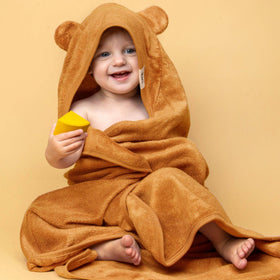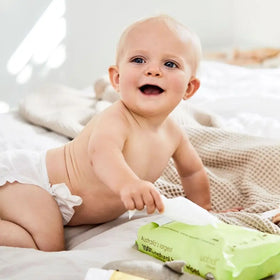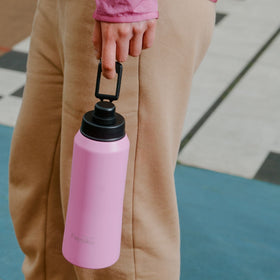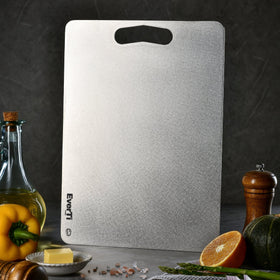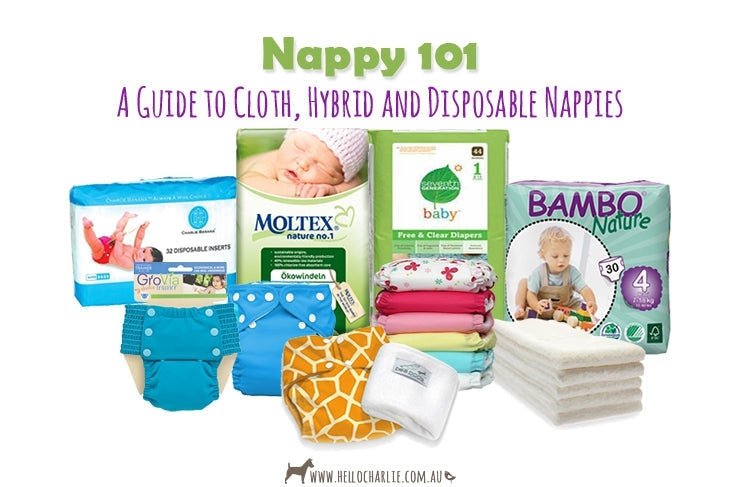
Nappy 101 - A Guide to Cloth, Hybrid and Disposable Nappies
Whenever I think of my youngest brother as a baby, I have a mental image of him toddling around in a saggy terry nappy and blue gumboots. One of our funniest family photos is an old PixieFoto, with him on my lap in a wet nappy leaking through on to my dress, and my face showing exactly what I thought of it!
My mum wasn't thinking of the environmental impact when she used cloth nappies. There was no such thing as an eco nappy back then, and disposables weren't yet widely available in Australia. It was terry squares and stabbing yourself with nappy pins in the middle of the night, or nothing.
When I decided to use cloth nappies with my babies, my mum thought I was mad. Until she saw how easy modern cloth nappies had become, that is. There are so many nappy choices now, from terry squares to all in ones, hybrids to eco disposables. But precisely because there are so many different kinds of nappies you can use with your baby, it's understandable if the choice seems overwhelming. So let's start by discussing all the different nappies available. There are three basic kinds of nappies - disposables, cloth (often known as washables or reusables), and hybrids.
Different types of cloth nappies
Flats
Flat nappies are a large, single piece of absorbent fabric, usually in a square shape. You can fold them in a variety of different ways to fit your baby, held together with nappy pins or snappis, and then usually covered up with a nappy cover or pilcher to make them waterproof. Flat nappies are usually made of absorbent terry cotton or flannel, but you can also find them in muslin and bamboo versions. This video shows you how to fold flat muslin nappies in four different ways, and this one shows you how to fold thicker terry nappies. Flats are generally the cheapest type of cloth nappy, due to their simplicity. It's also very easy to repurpose the nappy after baby is toilet trained.
variety of different ways to fit your baby, held together with nappy pins or snappis, and then usually covered up with a nappy cover or pilcher to make them waterproof. Flat nappies are usually made of absorbent terry cotton or flannel, but you can also find them in muslin and bamboo versions. This video shows you how to fold flat muslin nappies in four different ways, and this one shows you how to fold thicker terry nappies. Flats are generally the cheapest type of cloth nappy, due to their simplicity. It's also very easy to repurpose the nappy after baby is toilet trained.
Prefolds
Prefold nappies are an absorbent piece of cloth that’s been folded and sewn to create an  absorbent area down the middle. This reduces the bulk of the nappy, but still provides absorbency in the middle, which is where it’s needed. These are then folded again into thirds to create a long rectangle, and inserted into a waterproof cover. There’s a great explanatory video of how to use prefold nappies here. Prefolds are usually very reasonably priced, too, as they're simple to make. You will need to buy some covers, though. Like the flat nappies, it's very easy to repurpose the nappy as rags or cleaning cloths once baby is out of nappies.
absorbent area down the middle. This reduces the bulk of the nappy, but still provides absorbency in the middle, which is where it’s needed. These are then folded again into thirds to create a long rectangle, and inserted into a waterproof cover. There’s a great explanatory video of how to use prefold nappies here. Prefolds are usually very reasonably priced, too, as they're simple to make. You will need to buy some covers, though. Like the flat nappies, it's very easy to repurpose the nappy as rags or cleaning cloths once baby is out of nappies.
Fitted Nappies
Fitted nappies are also called shaped nappies, or contoured nappies. They're similar to prefolds in that they are one piece of fabric, but they've been cut and sewn to your baby's shape. They often fasten with velcro or poppers. You then use a cover or a pilcher to make them waterproof. 
They’re not as popular now, probably due to the fact that the material is very thick and takes a while to dry. They're usually available in either different sizes, or one size that grows with your baby.
They're available in a huge variety of fabrics, from cotton and organic cotton, to microfibre fleece, hemp and bamboo. Because there's so much absorbent fabric in a fitted nappy, they're great at containing leaks and are a good choice for a baby that wets a lot, or for using overnight.
Fitted nappies are a two part nappy system, and were the first of the new generation of modern cloth nappies (MCN's). Fitted nappies are the precursor to the all in two (AI2) nappies that are more popular today. This video shows a good example of a fitted nappy.
They can be sized, which is sometimes helpful for smaller babies, as a cloth nappy can be very bulky on a newborn. You can also buy one sized nappies, which adjust to fit your baby as he grows. This is obviously more cost effective, as you're only buying one set of nappies.
Fitted nappies are more expensive than flat or prefolds, but generally not as expensive as all in one, all in two or pocket nappies. You do need to buy the covers separately, but you don't need as many of them because you don't change the covers at each nappy change. Fitted nappies can also be cooler for babies in summer, as you can leave the waterproof cover off.
All-in-Two Nappies
An all-in-two- nappy (AI2) is a modern cloth nappy that comes in two parts. An all-in-two nappy has a waterproof nappy cover with fasteners and an absorbent insert. The insert is a rectangular or shaped pad of absorbent material. Sometimes the insert has a layer of moisture wicking material on the top to keep moisture away from baby's skin. The insert snaps into the cover, or sometimes just lays inside the cover, and when it's dirty or wet you just remove it and replace with a clean one. You can reuse the cover until it's dirty or wet.
AI2 nappies are different to fitted nappies, because fitted nappies can be used completely separately to the waterproof covers. With an AI2 nappy, you can't use the insert by itself. However, the inserts in an AI2 nappy dry a lot faster than a fitted nappy, because there's a lot less fabric.
AI2 nappies are often used as hybrid nappies, where you pop in a disposable insert instead of the washable one when you're out and about. You can buy AI2 nappies in different sizes, which means that you'll need to buy new nappies as baby grows, but sometimes this means you get a better fit and less leakage, especially on tiny babies. You can also buy one size nappies that adjust as your baby grows.
Pocket Nappies
Pocket nappies are another type of modern cloth nappy. They have a waterproof outer layer, and as  the name suggests, a pocket into which you slide an absorbent insert. Generally, the layer of fabric next to baby's skin is made with something like microfleece which wicks the moisture away, although you can also get pocket nappies like the Pea Pods that allow you to add snap in boosters next to baby's skin for extra absorbency.
the name suggests, a pocket into which you slide an absorbent insert. Generally, the layer of fabric next to baby's skin is made with something like microfleece which wicks the moisture away, although you can also get pocket nappies like the Pea Pods that allow you to add snap in boosters next to baby's skin for extra absorbency.
Pocket nappies also allow you to adjust the absorbency levels by stuffing the pocket with extra inserts. This means that you can add more inserts at nighttime, or less during the day when your baby is more active and doesn't want as much bulk.
If the pocket nappy has a snap on insert, you simply snap the insert out and change that. If it doesn't, you need to change the whole nappy at every change.
All-in-one Nappies
An all in one (AIO) modern cloth nappy will be the most familiar to people who are used to disposable nappies.  There's no assembly required, as everything is already built in. You don't have to fold, or stuff, or look for separate covers, it's all there. There's a waterproof outer layer, and absorbent material inside next to baby's skin.
There's no assembly required, as everything is already built in. You don't have to fold, or stuff, or look for separate covers, it's all there. There's a waterproof outer layer, and absorbent material inside next to baby's skin.
They're designed to cut down on drying time, too, with sections that pull apart. AIO cloth nappies are ideal for parents wanting to use cloth nappies at childcare, or with grandparents, as they're the simplest to use of all cloth nappies. When your baby wets or dirties the nappy, you change the whole nappy, in the same way that you would with a disposable.
You can usually add extra absorbency simply by placing an extra insert into the nappy, although some designs allow you to snap in extra inserts if you want.
AIO cloth nappies close with either snap or velcro fasteners, and they're generally available in one size or sized nappies. Because everything is built in and you need to change the whole nappy each time, AIO's can be the most expensive option. However, if you are planning on having more than one baby, AOI's will pay for themselves with reuse.
Hybrid nappies
Hybrid nappies are a combination of washables and disposables. Generally, there's a washable outer shell, and an inner absorbent nappy pad that you dispose of in the rubbish or the compost. Some local councils allow the disposable nappy pads to be put into the green bin.
Most hybrid nappies allow you to use disposable inner pads when you're out and about, or a washable cloth nappy pad when you're at home. In this way, you can combine the convenience of disposables with the reduced environmental footprint of cloth nappies.
There are a number of hybrid brands around, including Charlie Banana, which come with the option of disposable or reusable insert; Gently, which have a disposable insert only, and they're reasonably priced; Eenee offers reusable shells with the choice of disposable and compostable inserts or washable microfibre inserts; Grovia also has a hybrid with both washable and reusable inserts.
Hybrid nappies are a great option if you're a dedicated cloth nappy user, but you want the occasional convenience of a disposable. However, hybrid nappies can be the most expensive option of all, as not only do you need to buy the nappy outers, the disposable inserts can be as expensive as buying disposables.
Disposable nappies
Disposable nappies are just that - disposable. Use them once and put them in the bin. Their convenience makes them the most popular choice by far for Australian parents when it comes to nappies, with an estimation that 95% of babies are in disposables. Of course, the popularity of disposable nappies means that there's a wide range of nappies to choose from. Standard disposables are generally the ones that you find in supermarkets. Huggies, Pampers, Snugglers, Baby Love, and supermarket own brands like Comfy Bots and Homebrand, are a few of the standard disposables you'll find on the shelves. 
Becoming more widely available in the last few years, eco disposables are becoming more and more mainstream. These are brands like Bambo Nature, Moltex, Muumi, ecoriginals, Noopii and Tooshies. These have all the same features and convenience of standard disposables, but with a much lower environmental impact or and without any of the nasties like perfumes and lotions.
As with any product that claims it's green or more environmentally friendly than another, you need to do your homework and make sure that you're not falling for greenwash. You can check out Hello Charlie's Safer Disposable Nappy Cheat Sheet to help you navigate your way around disposables.
Which type of nappy to choose?
As you can imagine, this is a question that we're often asked at Hello Charlie. As a mother myself, and having chatted to hundreds of other mothers about nappies over the years, I always recommend starting the first few weeks with some eco disposables.
Newborn babies shouldn't have perfumes and lotions next to their skin, and all the standard disposables contain these. Even if you're planning on using cloth nappies, give yourself some time to recover from your baby's birth, and get used to having the baby around. Piles of cloth nappies to wash every couple of days when you have a brand new baby can be overwhelming. Cloth nappies can also be very bulky on newborns, leading to leaks, wet clothing and even more washing.
Get some samples of various types of disposables that you might like to try, and get one of each type of cloth nappy that you like. Test them all out, and see which ones you like best before you commit yourself to spending a lot of money on something that you may decide that you don't like.

